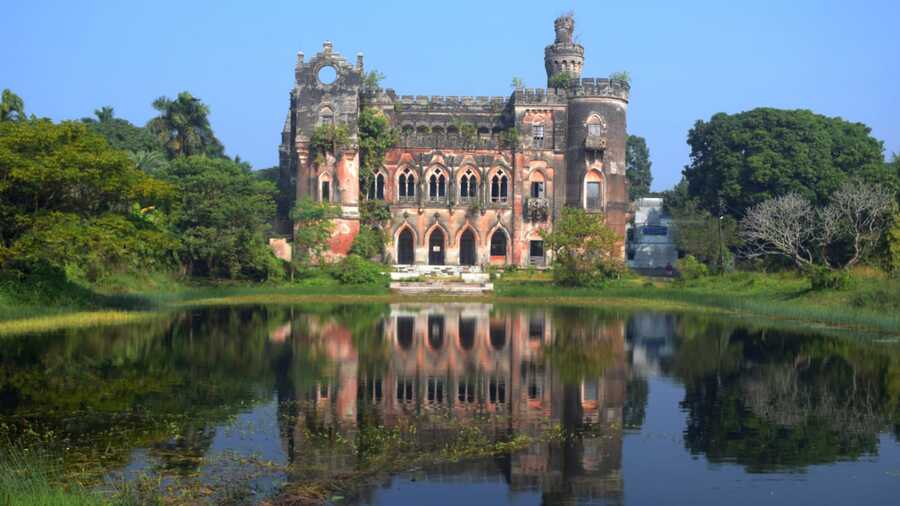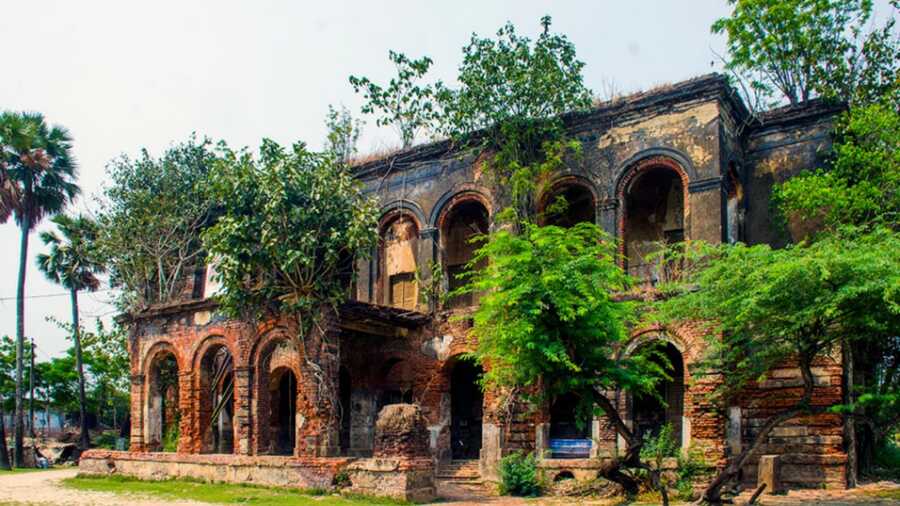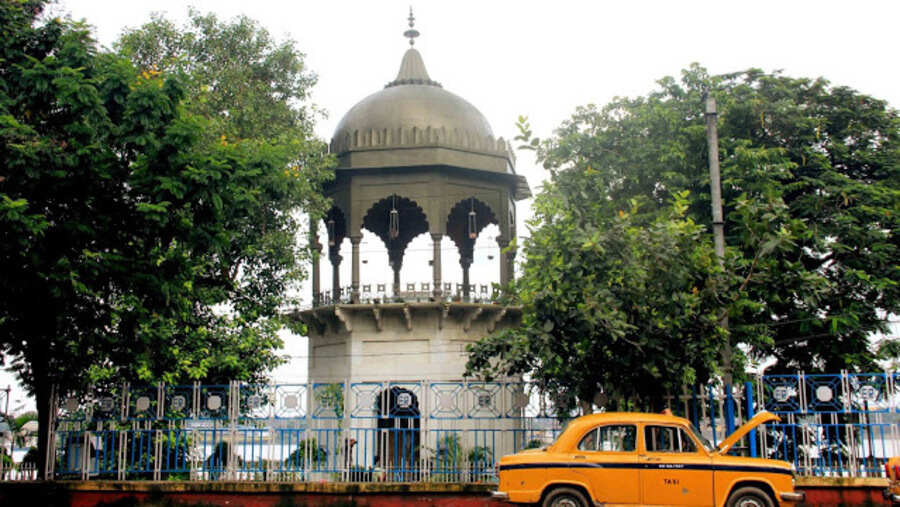A European castle in Bengal seems like a far-fetched notion. While the English built a number of sweeping mansions and buildings — even a few forts — during their time in India, a castle was not as prevalent.
Along the Barasat-Taki road, when driving from Kolkata towards Basirhat, curious visitors might notice a gate with towers in a medieval European-architectural style. On close observation, you can see a statue of two men battling a lion. A peek beyond the gate shows a mansion resembling a small medieval English castle. Locals refer to this mansion as Gaine Castle, Gaine Garden or Gaine Baganbari. A signboard proclaims that entry without permission is restricted, the point emphasised by a police picket.
The location of this building is in Dhanyakuria, about 52km from Kolkata in the North 24 Parganas district, and often referred to as the ‘village of palaces.’
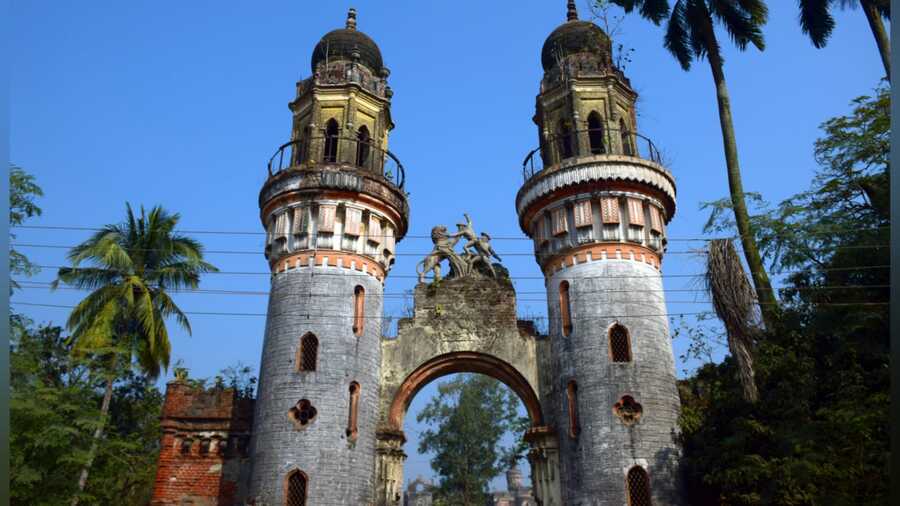
The Gaine Baganbari resembles a European estate or castle but also has features that blend different architectural styles of the time
The village of palaces
Dhanyakuria is steadily gaining popularity as a tourist destination. In recent times, the village is slowly getting featured as a tourist destination. The short distance from Kolkata, and the ruins of many lavish mansions, along with its proximity to two nearby popular tourist spots — the archeological site of Chandraketugarh near Berachampa and Baba Lokenath’s birthplace Kachua Dham — have put Dhanyakuria on the radar.
So, what’s the story behind Dhanyakuria’s mansions? Some historical accounts document that the village was part of the Sunderbans about three centuries ago and converted to a settlement in the mid-1700s when one Jagannath Das settled here with his family.
Following Das, many tradesmen moved to the area with their families, among them were the Mandal, Gaine, Sawoo and Ballav families. Members of these affluent families traded with the British and were the ones to build the mansions. It can be assumed that the European influence came from their business connections with the East India Company. Members of the three families were also responsible for building the area’s first schools and hospitals.
The Gaine Baganbari
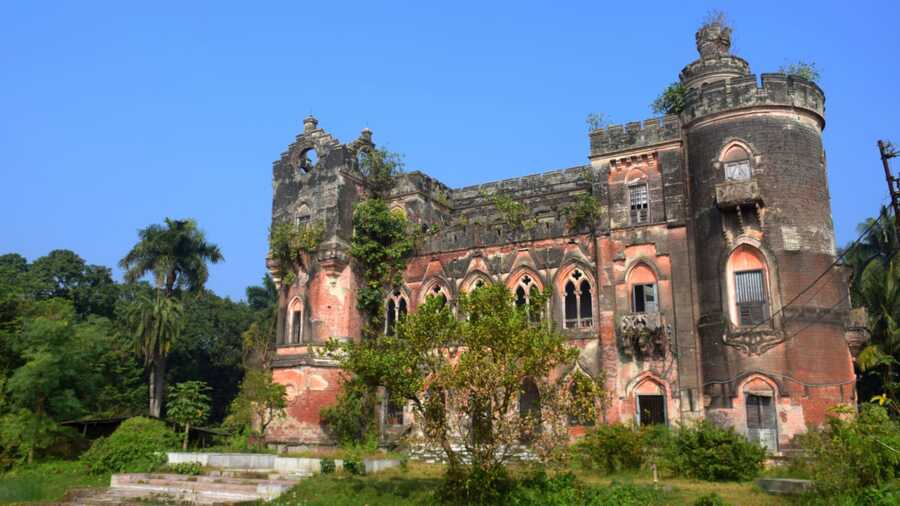
The most notable of Dhanyakuria’s buildings, it was built by Mahendranath Gaine, a wealthy landlord and businessman who flourished during the beginning of the 20th century trading in jute, jaggery and other agricultural products.
The rundown state of the castle-like baganbari does not take away from its striking architectural features. Its charm lies in the fact that it is yet untouched — the arches on the balcony and doors have not been modified yet. At first glance, the Gaine castle could remind you of any of England’s famous castles such as Windsor.
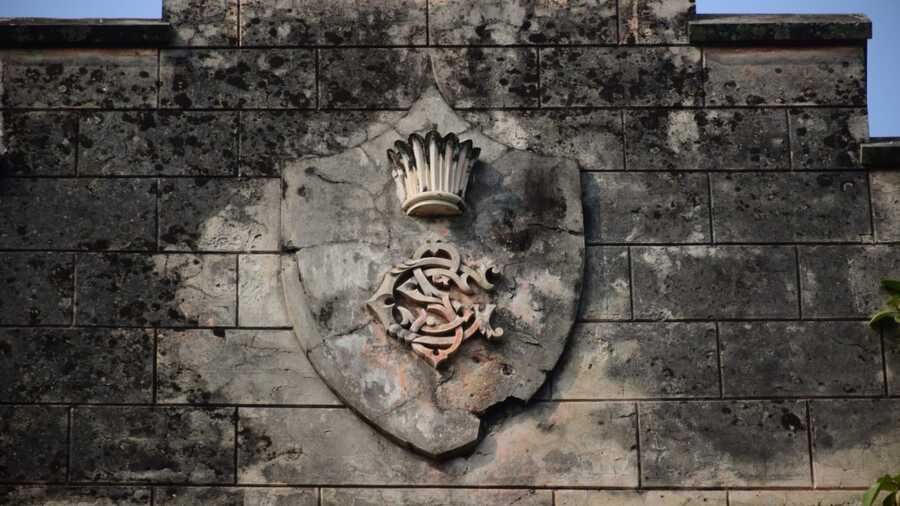
The Gaine family’s coat of arms on an exterior wall
The Gaine family’s coat of arms, a complicated entwining design of what might be assumed are the letters ‘G’ and ‘S’, can be seen on at least three spots on the exterior walls. Sculptures of faces of jesters stick out from on the walls below the first floor balcony as well, almost like gargoyles. If allowed inside, visitors can see a roofed and columned portico.
The house passed along to the government later. The building once housed a state-run orphanage that shut down a few years ago. At present, a police picket keeps trespassers away and permission needs to be taken from the local police station to visit it.
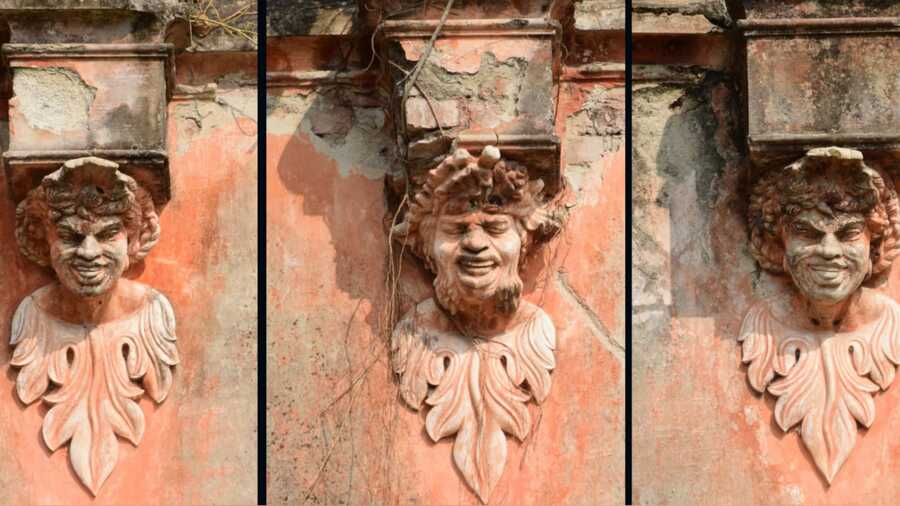
Sculptures of laughing jesters on the facade of Gaine Garden
The Gaines had another mansion in Dhanyakuria. A lane just beside the baganbari called Dhanyakuria Benepara Road, takes you to the still well-maintained mansions of the Gaine, Ballav and Sawoo families.
The condition of the Gaine Castle has worsened in recent times, but a glimmer of hope comes with the news that the West Bengal Heritage Commission has taken an interest in taking over the property for restoration.
The Gaine Mansion

The first grand mansion to greet you is the residence of the Gaine family. It was built by Gobinda Chandra Gaine and later by his son, Mahendranath Gaine somewhere in the mid-19th century. Owner of many jute mills and a prominent member of the Bengal Chamber of Commerce, Mahendranath Gaine was the most illustrious member of the family.
The light pink-coloured, L-shaped Gaine Mansion is an excellent example of the melding of architectural styles, a common feature of many colonial-era buildings built by affluent Indians. British patronage influenced tastes and sprawling homes were built in the style of estates in Europe. The open corridors on either side of the two-storied mansion are supported by Ionian pillars and connect the various rooms. Domed towers flank the sides of the home, adding to the grandeur of the building, one of them sporting coloured-glass ventilators.
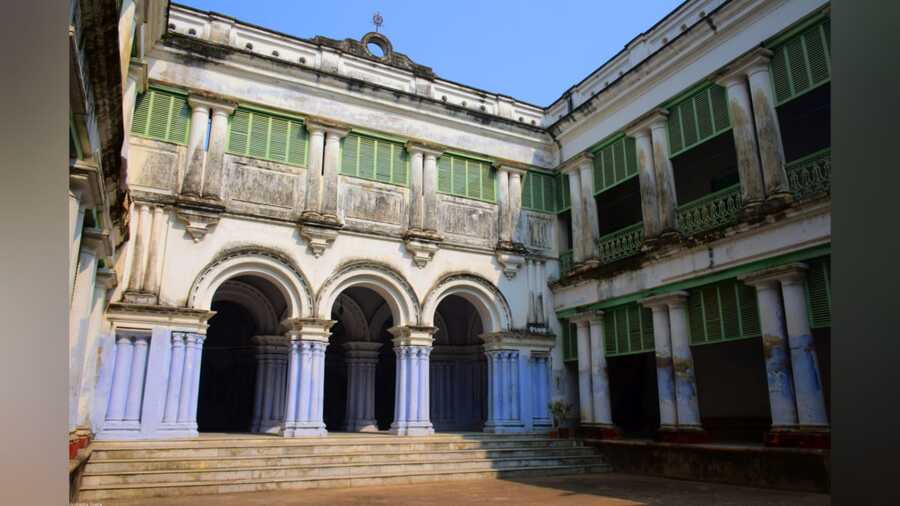
The Gaine mansion’s ‘Durga Dalan’ has been featured in Bengali, Hindi and foreign films
A three-storied domed tower named Nazar Minar stands inside the premises. Decorative Corinthian pillars flank four corners around the tower, which has an amalgamation of architectural features including rounded and Islamic-style archways.
Visitors cannot access the interiors of the mansion, since it is still owned by the family and the home of Monjit Gaine and his family, who are descendants of the family. The family still celebrates Durga Puja with great aplomb and the idol is enshrined in the home’s Durga Dalan. A temple of the family deity, also contructured in a familiar L-shape and pink in colour stands beside the home and is said to have been established around 1821.
Sawoo Mansion and Swaoo Baganbari
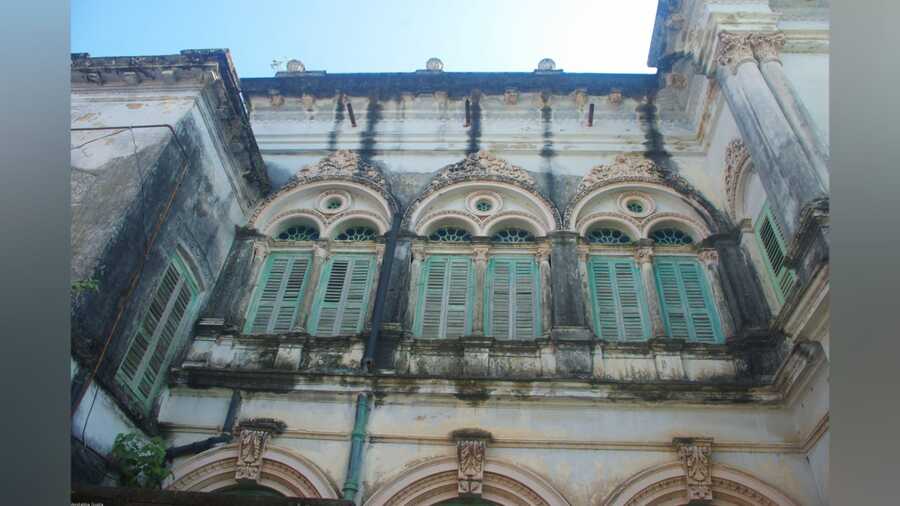
On the lane opposite Gaine Mansion is the sprawling, white Sawoo Mansion. Corinthian pillars, window arches along with stained-glass and stucco work are prominent features of this house built by Patit Chandra Sawoo around 200 years ago.
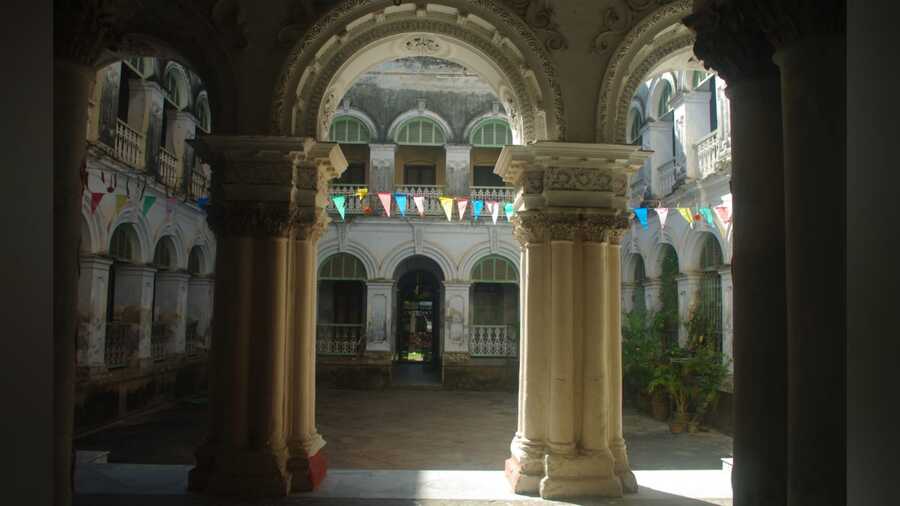
The Sawoo mansion’s ‘Thakur Dalan’
A stained-glass archway adorns the entrance that leads to a courtyard, and visitors are usually welcome to see the building and grounds. Connecting corridors are seen here as well, and in front of the entrance is a beautiful Thakur Dalan that has five archways, each with rich stucco work on the lunette (half moon-shaped space above a door or doorway). Through a row of similar archways, you can reach the inner sanctum of the Thakur Dalan.
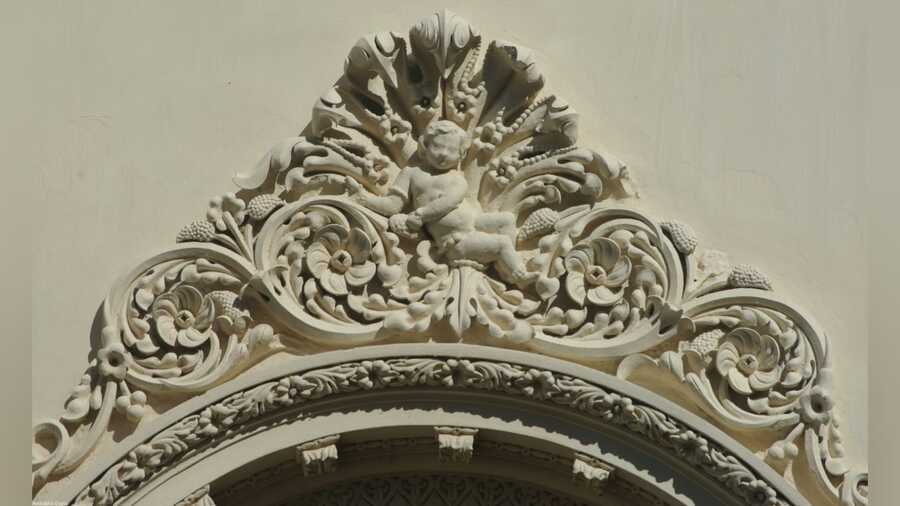
There is fine and well-preserved stucco work on the lunettes and arches of Sawoo mansion
Close to the mansion is the Swaoo family’s baganbari, stretched out on an area similar to the Gaine Baganbari. Though impressive, it doesn’t quite hold up to the grandeur of the former.
The Sawoo family does not stay here. A caretaker looks after the premises, and is usually available in the early morning hours.
Ballav Mansion
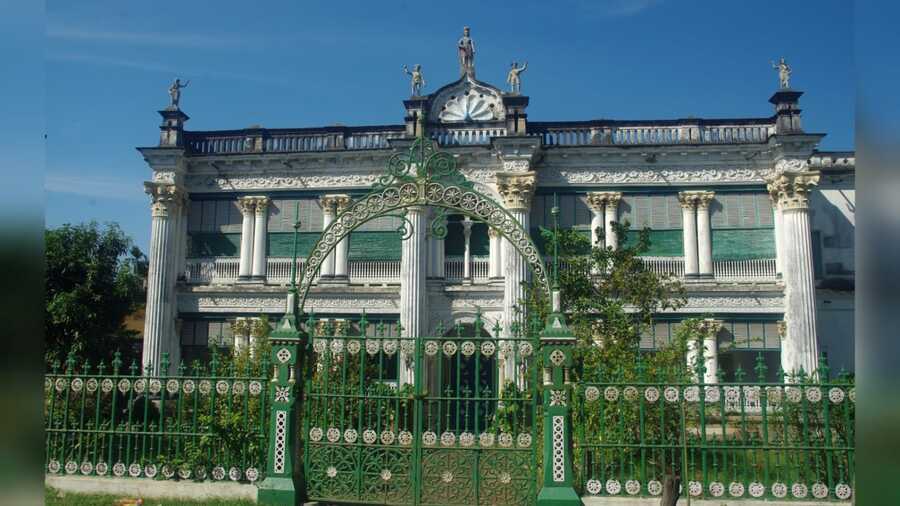
Behind the Sawoo mansion, past the little pond is the two-storied grand residence of the Ballav family. It is often called putul bari by the locals due to the many figures that adorn its front facade.
Ballav Mansion, also known as Ballav Bati, was built by Shyamacharan Ballav around the same time that Gaine Mansion was constructed. The present generation of Ballavs live in various parts of West Bengal. A huge mansion of the Ballav family stands near R.G. Kar Hospital in north Kolkata.
Painted in green and white, the mansion has exquisite iron gates and fencing of the same colour combination in front. An interesting display of figurines greets visitors at the entrance. Topping the lunette with a stucco-word peacock over the railing of the terrace, right above the entrance is a trio of sculptures — a fair-skinned, cape-wearing princely figure in the centre, and two turban-wearing Indian men who seem to be announcing him. Perhaps this was a token installation to show loyalty to the British patrons.
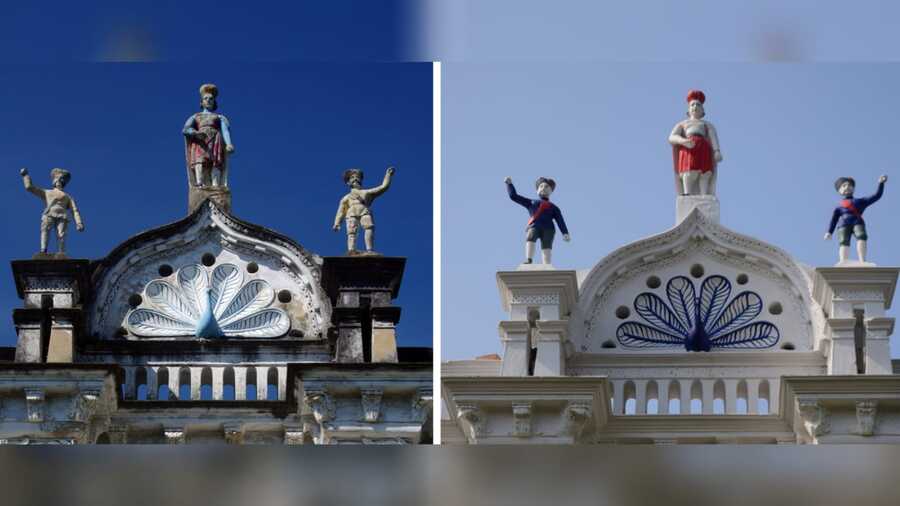
The notable trio of figurines at the entrance of the Ballav mansion, photographed six years apart
Apart from huge Corinthian pillars, the front of the building has rows of stucco over the corridors on both floors. The corridor of the top floor is covered with window shades. The tops of the two front pillars that extend to the railing of the terrace are single figurines in European attire.
Just outside the premises of the mansion, at one end is a three-storied tower similar to the Nazar Minar of the Gaine family. The Ballav family does not live in this home anymore and the caretaker is not often available, so it may not be possible to enter the premises.
The Rashmancha
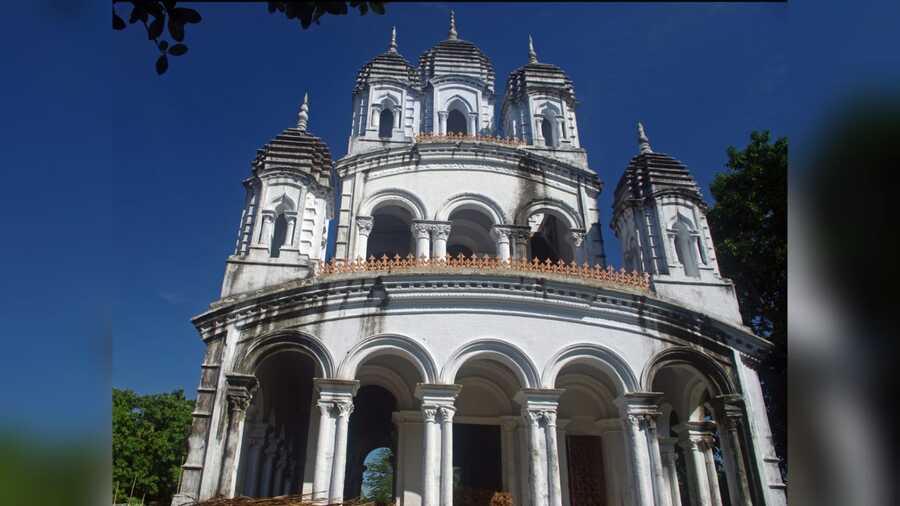
Further down the road is a two-storied rasmancha with a nine-pinnacled roof. During the Vaishnava Ras Festival, idols of Radha Krishna are worshipped here. It has a five-arched entrance on each side and like Thakur Dalan of the Sawoo house, each pillar besides the archways comprises a number of small Corinthian pilasters.
Vaishnavism was part of the social fabric of Dhanyakuria and the Ras Festival is still celebrated by many here. Many Vaishnava texts were written here, mainly by the old Kavasi family and distributed by the Ballavs. The huge rasmancha is evidence of this history.
A trip to Dhanyakuria can be a refreshing day trip, especially during Durga Puja, when the grand houses celebrate the festival and village comes alive
Travel details:
- Buses going from Ultadanga to Basirhat via Barasat and Berachampa can take you to Dhanyakuria
- The nearest railhead is Kankra Mirzanagar on the Sealdah – Hasnabad line. Local conveyances are available from the station to Dhanyakuria.
- There are not many eateries, only a few local shops and a sweet shop near Sawoo Mansion. If you leave early, a tour of Dhanyakuria can be completed in half a day
Amitabha Gupta is a travel writer and a photographer who specialises in heritage and history of West Bengal. His work has been featured in many magazines and newspapers — both online and offline. He also conducts heritage walks and tours in and around Kolkata.
